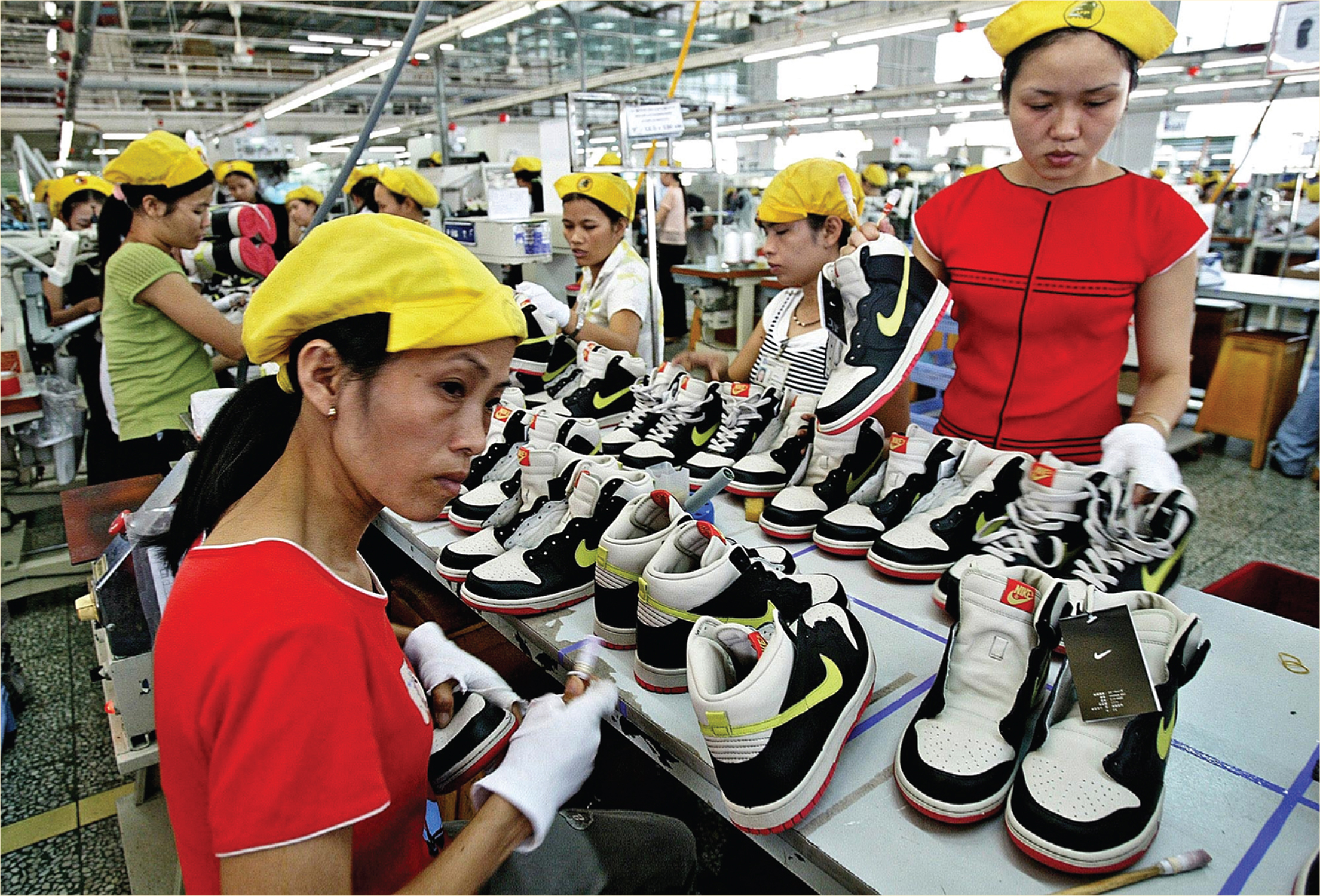The American Promise:
Printed Page 904
Chapter Chronology
BEYOND AMERICA’S BORDERS
Jobs in a Globalizing Era
In 2001, Paul Sufronko, a supervisor at Rocky Shoes and Boots in Nelsonville, Ohio, handed out final paychecks to the company’s last sixty-seven employees in the United States, ending a process of outsourcing that had begun in the 1980s. Before his own job ended, Sufronko traveled to Rocky plants in Puerto Rico and the Dominican Republic to train local workers to replace him. Asked about his job loss, the thirty-six-year-old said, “I had other plans. Things just didn’t work out.”

Making Nikes in Vietnam In 1995, Nike began to contract with Vietnamese factories to produce footwear. In the United States, Nike faced protests and boycotts over working conditions in Vietnamese plants, but their wages surpassed those available to most Vietnamese. These workers in a plant just outside of Ho Chi Minh City were among some 130,000 Vietnamese producing Nike products in 2005. AP Photo/Richard Vogel.
Other Americans did not take the loss of their jobs to foreign workers so philosophically. An autoworker believed that “corporations are looking for a disposable workforce. . . . No commitment to community; no commitment to country.”
In 1960, American workers made 96 percent of all shoes bought in the United States; by 2000, nearly all shoes came from abroad. The globalizing process was not a new experience for Julio Lopez, a temporary beneficiary of Rocky’s outsourcing of labor. After Lopez lost his job of twenty-three years when his employer moved production overseas, he found work at Rocky’s Puerto Rico plant at a rate of $5.15 an hour, less than half of what Nelsonville workers had earned. Lopez hoped that the factory would stay in Puerto Rico for eight more years. “Then I will be sixty-two, and I can retire.” Lillian Chaparro, the plant manager, spoke about the perpetual motion of jobs: “It’s like a chain, you know? The jobs leave the U.S. They come here. Then they go to the Dominican, to China. That’s why I push people—we have to be able to compete.”
The athletic shoe manufacturer Nike was one of the first to exploit the advantages of production abroad, turning to Japan in the 1960s. When labor costs there began to rise, Nike shifted production to South Korea. When Korean workers demanded better wages and working conditions, Nike turned to China and other Asian countries. Local contractors in Indonesia paid workers as little as fifteen cents an hour as they produced seventy million pairs of shoes in 1996.
Charles Seitz, who lost his job at Eastman Kodak when the company moved some operations to China and Mexico, was not entirely wrong when he said, “There’s nothing made here anymore.” The proportion of American workers in manufacturing jobs fell from one-third in the 1950s to 10 percent by the twenty-first century. Of course, not all the job losses resulted from outsourcing. At Kodak, for example, a machine replaced fourteen workers who previously had mixed filmmaking ingredients. In the 1980s and 1990s, American corporations sought increased productivity so that they could downsize their workforces and reduce costs. Moreover, some companies built plants abroad to be close to burgeoning markets there. Because so many companies, like Nike, contracted out production to foreign companies rather than employing foreign workers directly, the number of U.S. jobs lost to foreign workers is difficult to calculate.
The outsourcing of work did not end with manufacturing jobs. Corporations began to employ workers abroad, especially in India, for a wide range of service and professional work. For example, 1,700 engineers and scientists conducted research for General Electric in Bangalore, India. Technology experts in Bangalore provided telephone help for Dell computer users, and American schoolchildren received online tutoring from teachers in Cochin, India. A research firm executive pointed to the power of technology to overcome distance and noted, “You can get crackerjack Java programmers in India right out of college for $5,000 a year versus $60,000.”
The flight of jobs has not been entirely one-way. Seeking to move production closer to its market, in 1983 Japan’s second-largest automaker, Nissan, opened a plant in Smyrna, Tennessee, which would become the largest auto plant in the United States. The plant was non-union, and wages were lower than those of Michigan autoworkers. Yet Daren Shanks, who came from a Tennessee farming town, felt that his job on the engine line gave him “the opportunity to do stuff for my kids that I’d never have had the opportunity to do.” By 2007, nearly 5 percent of all American workers, and more than 10 percent of those in manufacturing, received their paychecks from foreign companies operating in the United States.
The majority of manufacturing jobs, however, moved in the opposite direction. In 2003, Levi Strauss and Company closed its last plants in the United States, contracting out its work in fifty other countries from Latin America to Asia. Marivel Gutierez, a side-seam operator in the San Antonio plant, acknowledged that workers in Mexico and elsewhere would benefit, suggesting the globalization of the American dream. “But what happens to our American dream?” Workers like Gutierez stood as stark reminders that as many reaped the benefits of free enterprise across national borders, globalization left multitudes of victims in its wake.
America in a Global Context
- Why did manufacturing jobs move from the United States to other countries in the 1980s and beyond?
- What impact did the outsourcing of jobs have on workers in the United States and elsewhere?
In what other ways did globalization directly affect the lives of millions of Americans?
